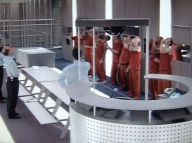Setting up
All participants were constantly monitored by cameras and microphones throughout the study. This gave us a complete behavioural record of everything they did and said.
We also gave participants questionnaires to complete every day. These addressed a wide range of factors, some social (e.g. their level of identification with their group), some organizational (e.g. their perceptions of the leadership in the two groups) and some clinical (e.g. participants’ level of depression). This allowed us to measure the psychological states of our participants and to examine their relationship to what people actually did.
Finally, we collected physiological data, by means of daily saliva swabs. These were sent to a laboratory and analysed for levels of cortisol – a measure of stress. This allowed us to examine the effects of the study on the well-being of participants.
Overall, by combining our different data sources – a strategy called triangulation – we were able to get a deeper insight into what people were doing and why. Ultimately too, it gave us much more confidence in the conclusions we were able to draw from the study.
